 |
||
|
||
| ||
TABLE OF CONTENTSFebruary has come and brought snow and frosts to Moscow... It's time to launch new products to "warm us"... :-) Some people bask in a new car, new jewel, a new bottle... Others are pleased with a new video card in their computers. Everyone to his trade. It's the first NVIDIA's attempt to expand the line of the G80 flagship (8800 series). The third video card is added. It was an expectable move - we can see that the top price segment already has the 8800 GTX (599-649 USD) and the 8800 GTS 640MB (499 USD). When released, cut-down modifications based on the new architecture will cover the sectors from $249 down. And the $299-$399 segment is not covered by the new generation. So it was decided to launch a new product in the $299 sector, based on GeForce 8800 GTS, but equipped with half as much memory - 320 MB. We also know that the GTS 640MB card goes down in price to $399. It frees the segment for the cut-down 8800 GTX, or the 8800 GTX 768MB flagship will go down from $599 to $499. We publish recommended retail prices for the American market. They will be higher by $100-$150 in Russia. That's how the updated GeForce 8800 series looks like:
The third product (new) is evidently identical to the second card except for the memory size. But its price is much lower. It's clear that the difference in price between 640MB and 320MB of memory cannot reach $200, so it's a purely marketing move. What products can compete with the new card? It's not easy to answer. RADEON X1950 XT 256MB or even X1900 XT, I guess. The AMD camp is not clearly graded due to many old products for various prices, so it's difficult to compare. That's why our tables will publish comparisons with several RADEON cards. What concerns old NVIDIA products, we'll compare with several cards. Logically, GeForce 7950 GT must be the competing product. And now about the cards themselves. We have tested three video cards from three manufacturers listed in the title of the article. I repeat that all 8800-series products are currently manufactured at third-party plants (Foxconn, Flextronics) ordered by NVIDIA. This company receives these cards and then sells them to its partners. That's why practically all GeForce 8800 cards are identical, because they are manufactured at two plants under strict NVIDIA control. But two of the three cards reviewed here offer increased frequencies. So after NVIDIA bought them, the cards were evidently tested in BFG and MSI labs. The companies selected samples that could work at increased frequencies. Video Cards
Our examination proved that all the three cards are based on the same PCB. That is they are typical representatives of reference cards. I repeat that all such cards are currently not manufactured by NVIDIA partners. The Californian company places orders at third-party plants and then sells ready cards to its partners. That's why all 8800 GTS/GTX cards are as like as two peas. Except for overclocked models, of course - they are already appearing on the market. Even in this case, they differ only in raised frequencies, the cards preserve their reference design. The MSI card is overclocked to the highest level, then goes BFG. The card from Foxconn offers the nominal clocking (operating frequencies). We should mention that BFG products, including this card, enjoy the 5(!) year warranty. All these cards have TV-Out with a unique jack. You will need a special bundled adapter to output video to a TV-set via S-Video or RCA You can read about the TV-Out in more detail here. Analog monitors with d-Sub (VGA) interface are connected with special DVI-to-d-Sub adapters. Maximum resolutions and frequencies:
What concerns MPEG2 playback features (DVD-Video), we analyzed this issue in 2002. Little has changed since that time. CPU load during video playback on all modern video cards does not exceed 25%. What concerns HDTV and other trendy video features, we are going to sort them out as soon as possible. All the cards require additional power, so each one contains a black 6-pin connector. If your PSU does not have this cable, the cards are bundled with a splitter to connect to any power cable with a Molex. Now about the cooling systems.
We monitored temperatures of these cards using RivaTuner (written by A.Nikolaychuk AKA Unwinder) and obtained the following results: Foxconn GeForce 8800 GTS 320MB PCI-E BFG GeForce 8800 GTS Overclocked 320MB PCI-E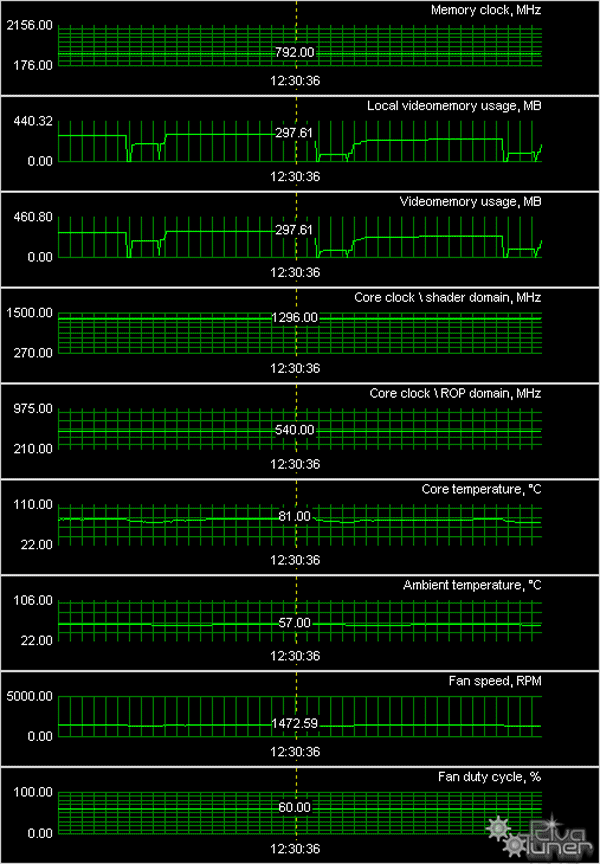 MSI GeForce 8800 GTS OC Edition 320MB PCI-E (NX8800GTS-T2D320E)
Even when the core is overclocked to 575 MHz, its temperature does not cross the dangerous line - I've already mentioned it. And fan speed does not grow much, so there is practically no noise.
Bundle
Packages
Installation and DriversTestbed configuration:
VSync is disabled. Test results: performance comparisonWe used the following test applications:
Video cards' performance
If you understand 3D graphics, you may draw your own conclusions from the diagrams below. What concerns beginners and those who just started to look for a video card, we shall include some explanations. Firstly, you should look through our reference materials on modern video cards and their GPUs. Note operating frequencies, support for modern technologies (shaders), as well as a pipeline architecture.
ATI RADEON X1300-1600-1800-1900 ReferenceNVIDIA GeForce 7300-7600-7800-7900 ReferenceSecondly, if you have just faced the problem of choosing a video card and are at a loss, our 3D Video section offers articles about 3D basics (you will still have to understand them - when you run a game and open its options, you'll see such notions as textures, lighting, etc) as well as reviews of new products. There are just two companies that manufacture graphics processors: ATI (it has been recently bought by AMD and now bears the same name - AMD) and NVIDIA. So most information is divided into these two sections. We also publish monthly 3Digests that sum up all comparisons of video cards for various price segments. Thirdly, analyze test results of the video cards under review. I just want to note that the new product is intended for up to 1600x1200 inclusive. So we shall not analyze performance in 2560x1600. FarCry, Research (No HDR)

We can see well that we should analyze only modes with antialiasing and anisotropy. These modes show that the 8800 GTS 320MB, even operating at its nominal frequencies, outperforms all its competitors, including more expensive cards. There are almost no differences from the 640MB modification of the 8800 GTS card, 320MB are enough.
FarCry, Research (HDR)

But HDR mode significantly drops performance, much lower than in RADEON X1950. So we can establish a fact that only the fastest accelerator from MSI (among our contenders) managed to become an absolute winner. Although the BFG product also demonstrated good performance. Differences from the 8800 GTS 640MB appeared clearly only in the highest resolutions. F.E.A.R.
All the three cards are successful here. Even the slowest card operating at the nominal frequencies (the 8800 GTS 320MB) demonstrated good results, being outperformed only by the more expensive 7950GX2. Splinter Cell Chaos Theory (No HDR)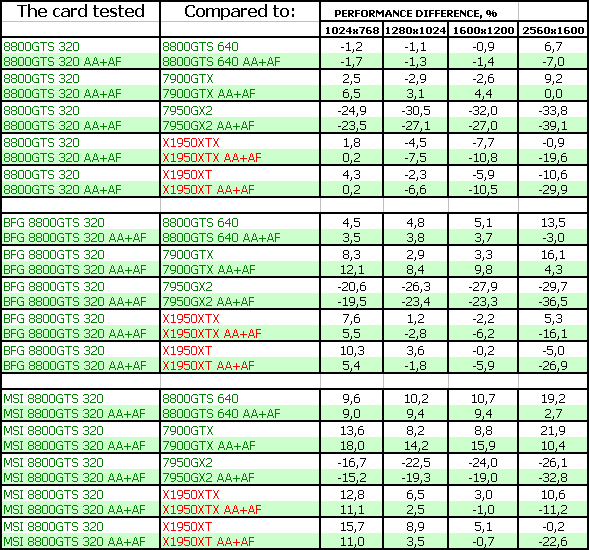
The situation changes in this game. Only the fastest product from MSI becomes a leader (the victory of the 7950GX2 does not count) And the other cards are actually on the level of the X1950 XT or even lower. But they are definitely better than the 7900 GTX. Consequently they are much better than the 7950GT (it's actually the 7900 GTX card operating at reduced frequencies). Splinter Cell Chaos Theory (HDR)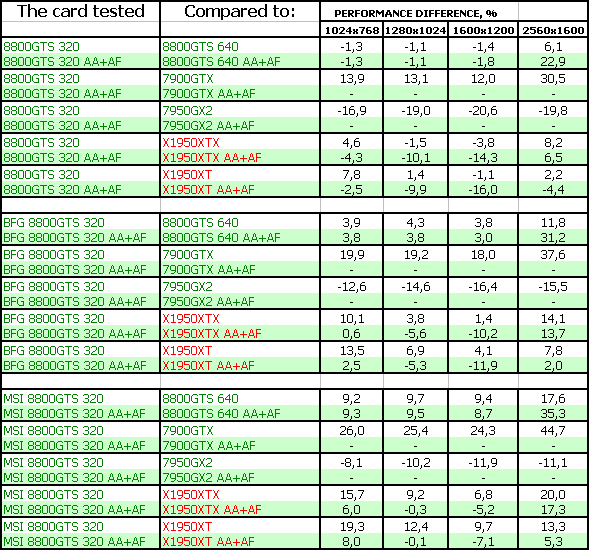
It's almost a similar situation. Performance drop from HDR in NVIDIA products is again a tad greater than in AMD products. Call Of Juarez
It's a new game, much more complex than even FEAR. The most powerful cards are brought to knees by maximum settings. That's where we can see the stunning superiority of the new cards over the previous generation. Have a look at the percentage. We don't even have to enumerate cards: the breakaway is so large! By the way, 320MB of memory are sufficient here as well, there are no differences from the 8800 GTS 640. BUT DON'T FORGET THAT 8800-SERIES CARDS WITH THE LATEST DRIVERS (mid February - Version 97.92) DEMONSTRATE GRAVE ARTIFACTS. SO IT'S TOO EARLY TO BE HOPEFUL. PERFORMANCE MAY DROP, WHEN THE BUG IS FIXED. Company Of HeroesTest results: CoH 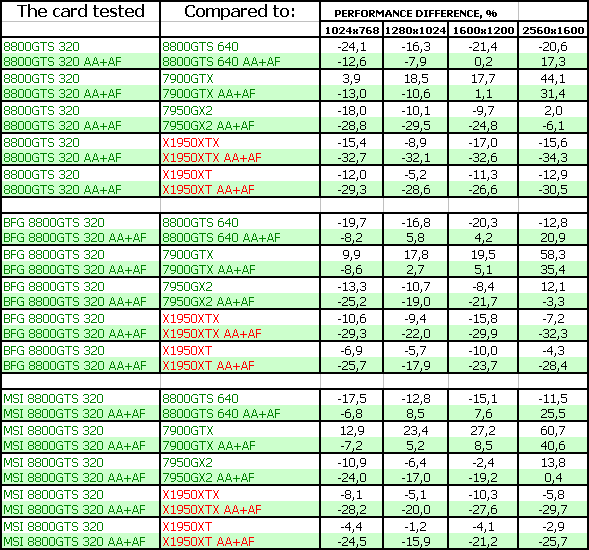
This is also a relatively new game. But look how radically the situation has changed! Alas, even the fastest 8800 GTS 320 from MSI is outperformed by RADEON X1950. Serious Sam II (No HDR)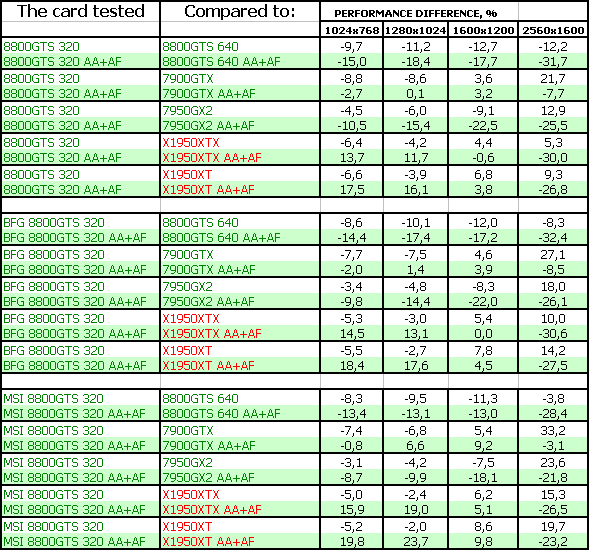
This test demonstrates a huge array of textures, memory size starts to play an important role: the difference from the 640MB card is great. On the whole, the 8800 GTS fares well in this game. Even the slowest modification. Serious Sam II (HDR)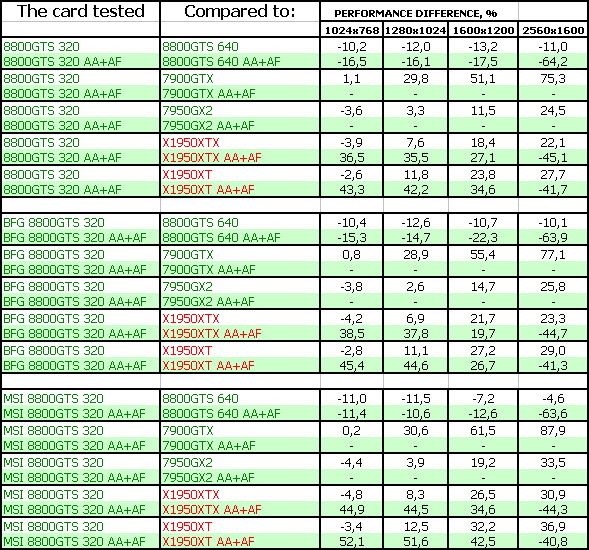
It's a similar situation here. We can see that the new cards win.
Prey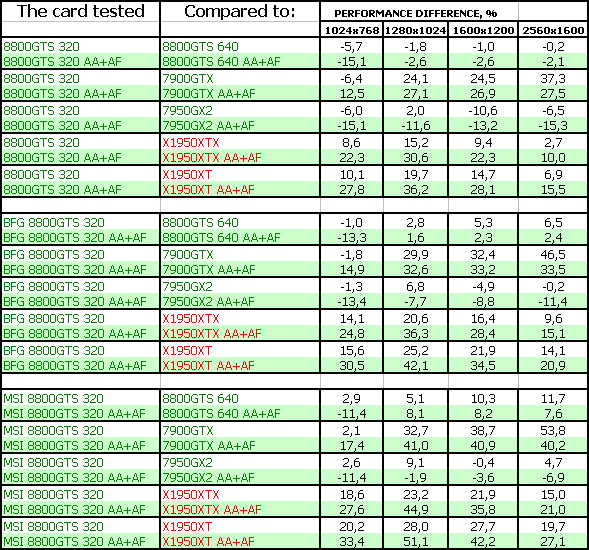
OpenGL and games based on engines from id Software have always been good to NVIDIA products. The 8800 GTS is at advantage in this case as well. 3DMark05: MARKS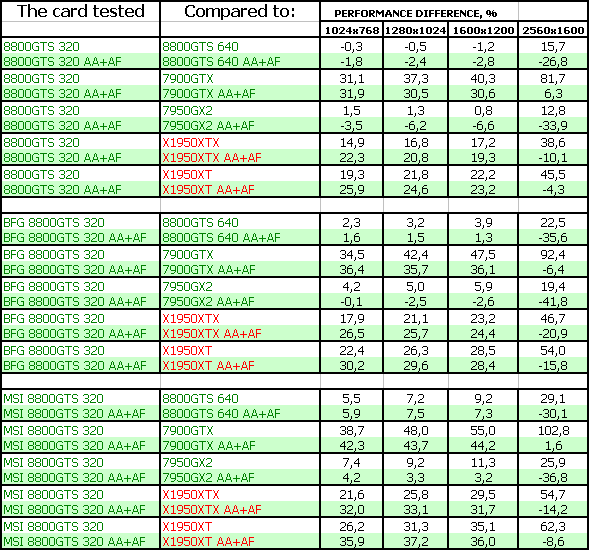
3DMark06: SHADER 2.0 MARKS

3DMark06: SHADER 3.0 MARKS
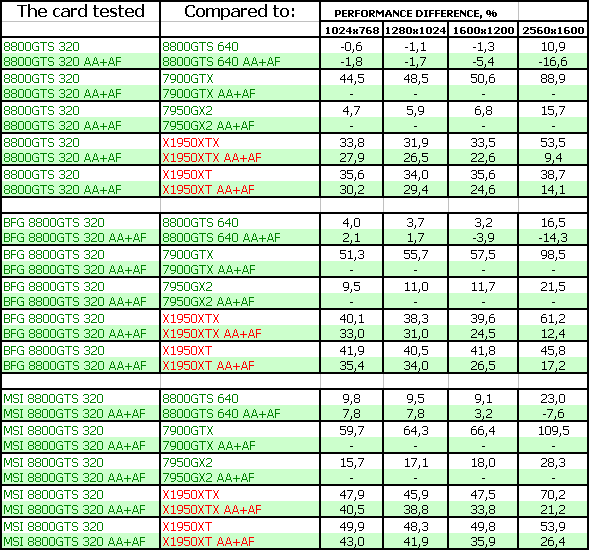
I'll analyze all 3DMark test results at once. There is actually nothing to say: The new products based on the 8800 GTS 320MB are always victorious. It was to be expected, considering characteristics of the cores and cards: the power of shader computations is evident. Conclusions
BFG GeForce 8800 GTS Overclocked 320MB PCI-E is an excellent product. If you see this card in a store, and its price is not too high, don't hesitate, take it right away. The bundle, 5-year warranty, increased frequencies... These are all additional advantages of this card. Watch the prices... And make your choice. Don't forget about the gamer's warning on the box (the man on the front side clearly says: if you play games for days on end, you'll end like he did). MSI GeForce 8800 GTS OC Edition 320MB PCI-E (NX8800GTS-T2D320E) is no less great an accelerator owing to its highest frequencies (among today's contenders). This accelerator may be designed for women - owing to the stylish handbag. The card fares very well... But! Everything will be up to the prices. Foxconn GeForce 8800 GTS 320MB PCI-E is a regular card. No increased frequencies. But it comes with a gamepad. Overclockers can set increased frequencies manually free of charge. I hope our readers understand that I was joking when wrote about increased frequencies of the card when used together with the bundled gamepad. On the whole, all the three cards were stable, we had no gripes with their operation. They are actually identical cards. Like three Mercedes cars: one is painted black for tough guys; the second is painted white for Don Juans; and the third is red - for blondes... But they are actually identical inside. Watch the prices! And don't say that you were not warned. All our conclusions may go to pot, if vendors raise prices so that the 8800 GTS 640MB is cheaper. By the way, speaking of the competition with RADEON X1950. Don't forget that the latter cards do not support DirectX 10 on the hardware level. And this technology belongs to the future. The choice is up to our readers, as always. We can only inform you about this or that product. But we do not give direct instructions which products to choose. And one more thing: having decided to choose a 3D accelerator on your own (a video card in your computer), you should understand that you change one of the key components of your system unit, which cannot and shouldn't work without proper configuration. This is not an end product, it's just a component. So you should understand that you'll have to learn 3D graphics basics in order to get maximum performance from a new video card. And some graphics as well. If you don't want to deal with it, you shouldn't upgrade your computer on your own: you'd better buy ready PCs with preconfigured software, or game boxes, where no configuration is required. You can find more detailed comparisons of various video cards in our 3Digest.
The following cards get the Original Design award (February):

Our Excellent Package award (February) is given to the following cards:

We'd like to thank
BFG Russia and Mikhail Proshletsov MSI Russia and Alexander Nemoshkalov Foxconn Russia and Alexander Trukhachev for the provided video cards
Andrey Vorobiev (anvakams@ixbt.com)
February 13, 2007 Write a comment below. No registration needed!
|
Platform · Video · Multimedia · Mobile · Other || About us & Privacy policy · Twitter · Facebook Copyright © Byrds Research & Publishing, Ltd., 1997–2011. All rights reserved. | ||||||||||||||||||||||||||||||||||||||||||